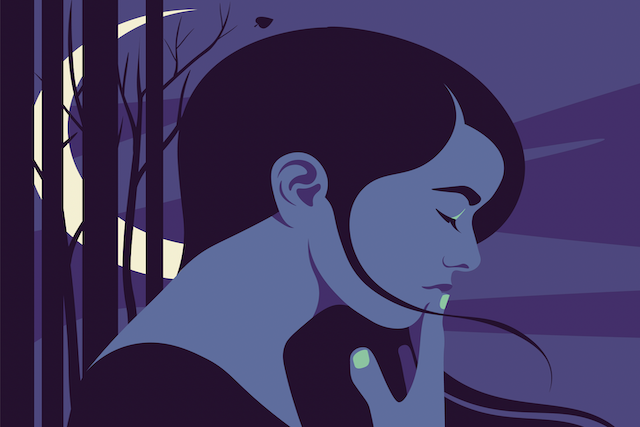Amoghasiddhi Essence of Lifeforce: Modern, Success-Oriented and Profound Practices of the Karma Buddha Family
Why is the Karma family, and especially Amoghasiddhi or Green Tara, an important practice in modern-times? Why is the entire family considered “success-oriented” in inspirational modern language? Why is he, and his Mother Wisdom partner Tara, green in color?...

 Amoghasiddhi Buddha. The “Tian Tan” or “Giant Buddha” at Po Lin Monastery Ngong Ping in Hong Kong is Amoghasiddhi, held his right hand up in Abhaya Mudra. This huge statue is on top of a mountain, with Amoghasiddhi’s gaze looking out on the Samsaric world protectively.
Amoghasiddhi Buddha. The “Tian Tan” or “Giant Buddha” at Po Lin Monastery Ngong Ping in Hong Kong is Amoghasiddhi, held his right hand up in Abhaya Mudra. This huge statue is on top of a mountain, with Amoghasiddhi’s gaze looking out on the Samsaric world protectively.Why is the Karma family, and especially Amoghasiddhi or Green Tara, an important practice in modern-times? Why is the entire family considered “success-oriented” in inspirational modern language? Why is he, and his Mother Wisdom partner Tara, green in color? What are his praises, practices and mantras? Why is he associated with “Chi” or prana and wind in the body? We answer these questions, and more, in this presentation.
Synonymous with Success
Amoghasiddhi’s name literally means Infallable Success or Accomplishment. Amogha means infallable and Siddhi means Accomplishment. Kyabje Garchen Rinpoche describes Amoghasiddhi this way:
“Among the victorious ones of the five families, Amoghasiddhi is the lord of the family of enlightened activities.” [3]
 Amoghasiddh’s symbolic color is green, for life and the breath of life and growth and thriving life. His hand is held up in the Abhaya or “fearless” mudra and his right hand is in the pose of meditative equipoise.
Amoghasiddh’s symbolic color is green, for life and the breath of life and growth and thriving life. His hand is held up in the Abhaya or “fearless” mudra and his right hand is in the pose of meditative equipoise.
This is highlighted especially each time we renew our Bodhisattva Vows, when we state the Karma vow verse:
“For the great, supreme Karma family, I shall uphold purely each of vows I am endowed with, and make as many offerings as I am able.”
For this reason, the Karma family of Amoghasiddhi family of Bodhisattva realization, where Bodhisattva activities are the main practice. Since Amoghasiddhi and the karma family are all about Enlightened activity, such as right conduct, holding vows and promises, benefiting others, and making offerings these are considered the highest and best practices of the Karma family of Amoghasiddhi and Mother Tara. In other words, the Dharma student who volunteers at a Dharma center or for any Dharma activity is by definition practicing the activity of Amoghasiddhi’s Karma family.
 Green Tara Prajna Wisdom Buddha of the North with Compassion Male Buddha Amoghasiddhi. They are symbolically shown in union to express that Wisdom Activity and Compassion Activity always work together.
Green Tara Prajna Wisdom Buddha of the North with Compassion Male Buddha Amoghasiddhi. They are symbolically shown in union to express that Wisdom Activity and Compassion Activity always work together.
Fearless Amoghasiddhi
Amoghasiddhi also embodies the virtues of “dauntlessness” and “fearlessness.” For this reason his family mudra is Abhaya, or the fearlessness mudra.
In the precious Shurangama Dharani, from the Sutra of the same name, the fifth section is devoted to the power of the Karma family. In line 373 Venerable Master Hsuan Hua translates as:
A canopy of incense pervades the entire great void.
Everywhere permeating the Dharma-nature of all sentient beings.
Superior strength enables us to hold the pure moral precepts.
The host of the Northern Karma Division is fair and just.
 Amoghasiddhi beautifully illustrated (Aloka, London Buddhist Center) showing the double Vajra (Vishvavajra) in his left meditative hand.
Amoghasiddhi beautifully illustrated (Aloka, London Buddhist Center) showing the double Vajra (Vishvavajra) in his left meditative hand.
7 Limbs of Practice and the Karma Family
The practice of the seven limbs is the most important of practice for Amoghasiddhi, Tara or their wrathful aspect of Vajrakilaya Father and Mother. Each of the limbs corresponds to one of the Buddha Families, but the Bodhichitta Intention and the Dedication of Merit are considered the most important of these. Why? It is through this motivation to benefit others that we are Mahayana Buddhists, dedicated to the Bodhisattva mission.
The seventh limb is “Dedicating the merit of all devotion, offerings and practice” to the benefit of all sentient beings. This purifies the poison of jealousy.
 Jealousy is a conditioned emotion that “starts when we are young.” The loving, fearless practice of Amoghasiddhi or Tara can help us decondition this artificial emotion.
Jealousy is a conditioned emotion that “starts when we are young.” The loving, fearless practice of Amoghasiddhi or Tara can help us decondition this artificial emotion.
The poison of jealousy is the specific domain of Amoghasiddhi, Tara and the Karma family. All activities, including the seven limbs prayer, are karma activities. This is Amoghasiddhi in action. This is why the name Amoghasiddhi is translated as “meaningful accomplishment.” It is meaningful accomplishment that defines the actions of a Bodhisattva hero.
For those who aspire to Amoghasiddhi, Green Tara, or Vajrakilaya practices, the 7 limbs of practice are the main practice, and dedicating the merit to the benefit of others is the most important principle.
 Amoghasiddhi, a beautiful Thankha from Handmade Handicraft.
Amoghasiddhi, a beautiful Thankha from Handmade Handicraft.
“Whatever is meaningful is accomplished”
Khenchen Thrangu Rinpoche in his book The Five Buddha Families and Eight Consciousnesses describes in full Amoghasiddhi’s realizations:
“Buddha Amoghasiddhi is the realization of all -accomplishing wisdom. The Tibetan name for Buddha Amoghasiddhi is Sangye Donyodrupa. The word donyod means “meaningful” and the word trubpa means “accomplishment”.
So Buddha Ammogasiddhi means “whatever is meaningful and fruitful is accomplished. “ He is also the complete purification of jealousy, which is a hindrance for both material and spiritual success. His activity is perfect accomplishment and fulfillment of meaningful aims. Furthermore, his activity removes ordinary daily hindrances such as illness and obstacles. This is why Amoghasiddhi’s activity is meaningful accomplishment.”
 A 14th century Amoghasiddhi Buddha statue.
A 14th century Amoghasiddhi Buddha statue.
Amoghasiddhi and Green Tara and their wrathful emanation Vajrakilaya Father and Mother also heroically represent fearlessness and protection in Buddhism. One of his best known title is the Buddha of Fearlessness. Likewise his co-equal Wisdom Mother Tara is famous as the hero and protector. For this reason, Amoghasiddhi’s sacred mount is a Garuda, who feeds on delusions and poisons and can only be ridden by a fearless rider. Another sacred creature is the Kinnara, who is half man or woman, half bird, who watch over humans in times of danger.
 Green Tara is the Mother of the Karma family and is the most active member of the family, the unfailing protective savior in Mahayana Buddhism. She is the co-equal Wisdom partner to Amogahsiddhi’s compassion. For an entire section of features on Tara, see>>
Green Tara is the Mother of the Karma family and is the most active member of the family, the unfailing protective savior in Mahayana Buddhism. She is the co-equal Wisdom partner to Amogahsiddhi’s compassion. For an entire section of features on Tara, see>>
Karma Prasiddhi Pureland
Every Buddha family has a Pureland, the pristine mind-essence of the Buddha. This is the place we can aspire to be born in our next lives to receive direct instruction from the Buddha. Unlike other Purelands, Amoghasiddha and Tara’s pureland is a Turquoise Green wildland, a pristine and beautiful forest.
 Tara’s Kandira Forest Tuquoise Pureland. For a feature on her Pureland, see>>
Tara’s Kandira Forest Tuquoise Pureland. For a feature on her Pureland, see>>
Vessantara, in his excellent book A Guide to the Buddhas, described an imagined, visualized encounter with Amoghasiddhi in his Pureland, which is called Karma Prasiddhi or Prakuta, and which also emphasizes the degree of “Fearlessness” we can develop as someone who practices Amoghasiddi. Vesantara wrote:
“After the last delicate rays of the setting sun have tinted the sky, night falls. You make your final journey, completing your circuit of the mandala, into the north, a country of green pine forests.
It is dark as you walk between the huge trees. In the forest you can hear rustlings and cries. It would be easy to become afraid, and turn back, but if you were to do so you would never meet Amoghasiddhi, the Buddha of the northern realm, whose name means ‘unobstructed success’.
You walk for hours, with the whispering wings of owls overhead. Finally, at midnight, you emerge from the forest into a clearing. Ahead of you is a palace made entirely of jade and emerald. It towers into the air, vertical, a mass of roofs and pinnacles.
You go forward eagerly, then stop. There is a gate to the palace, yes. It is in the shape of a great bow, string uppermost. However, the gate is set high up in the smooth wall. Only an eagle could enter such a gate. As you stand, not knowing what to do, you hear a great commotion from within the palace: rhythmic crashings.
Suddenly the bow-shaped gate lifts high and … a chariot, drawn by two strange figures. At first they look like eagles, with wings and talons. Then you see that their hands and torsos are human. In their hands they each hold a huge pair of cymbals, which they clash together as they fly.
On the chariot, seated on a green lotus seat, is a dark green Buddha, clad in scarlet robes. The light from his body transforms the midnight scene so that everything is radiant and clear. His right hand is raised in a powerful gesture, which seems to banish the darkness and fears of the night.
In his left hand sits a mysterious [Vishvavajra]: two diamond thunderbolts crossed and fused together . He hurtles effortlessly above you. As he does so, the huge pines are transformed into a forest of jewel trees. Has the green Buddha ridden out of his palace, or into it? Can you have been in his Pure Land all along, without realizing it?” [5]
 King Garuda, the activity of the Buddhas is always swooping, diving, in action against all that afflicts us. He and the Garudas are sacred to the Northern domains of Amoghasiddhi and are the antagonist of illness and poison because they are the enemies of nagas.
King Garuda, the activity of the Buddhas is always swooping, diving, in action against all that afflicts us. He and the Garudas are sacred to the Northern domains of Amoghasiddhi and are the antagonist of illness and poison because they are the enemies of nagas.
Fearlessness and Protection
Their mudra is Abhaya, the mudra of fearlessness, as we saw in Vesantara’s visualization, usually the right hand held up with five fingers outreached as if to say “stop.”
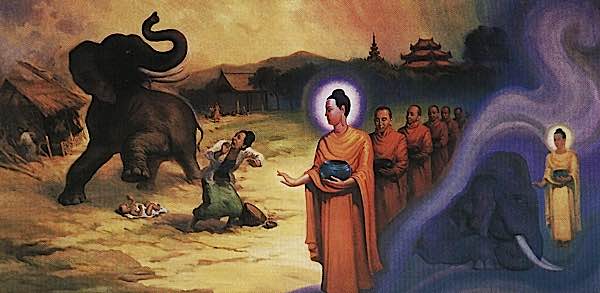 Shakyamuni subdues an elephant with loving kindness and the Abhaya gesture. The elephant was enraged by evil Devadatta. This is the mudra of Amoghasiddhi, the cosmic Buddha of Fearlessness.
Shakyamuni subdues an elephant with loving kindness and the Abhaya gesture. The elephant was enraged by evil Devadatta. This is the mudra of Amoghasiddhi, the cosmic Buddha of Fearlessness.
This is the same gesture that Shakyamuni used to calm the anger of the charging elephant, holding up his hand calmly in a “stop” gesture. We also saw in Vesantara’s visualization, his sacred mount, the powerful Kinnara. This is more than just a sacred animal. Lama Govinda explains:
“This Inner Way leads into the mystery of Amoghasiddhi: in which the inner and the outer world, the visible and the invisible, are united; and in which the spiritual takes bodily shape, and the body becomes an exponent of the spirit. For Amoghasiddhi is the lord of the great transformation, whose vehicle is the winged man, the man in transition towards a new dimension of consciousness.” [6]
 Amoghasiddhi in the Tahoto Pagoda of Renge-in Temple 蓮華院多宝塔の不空成就如来.
Amoghasiddhi in the Tahoto Pagoda of Renge-in Temple 蓮華院多宝塔の不空成就如来.
The winged man/bird is a Kinnara, the adversary of nagas and poisons. Garudas are also sacred to the north and the Karma family, and are the antagonists of the poisons that afflict us.
Amoghasiddhi as Hero-Savior
In many ways, the practice of Amoghasiddhi and Green Tara is the most practical and important of the five Dhyani Buddha Families. This is because Amogahsiddhi and Tara represent practical activity. They are also “known as the savior Buddhas.”
 A Bodhisattva rescuing a drowning man who called her name.
A Bodhisattva rescuing a drowning man who called her name.
What enables practical activity is fearlessness and also the element of air. Wind, or air, is, in Buddhist terms, the essence of lifeforce. Both are the domains of the Karma family of Amoghasiddhi and Green Tara, the windy Buddhas of the North.
Not only does Amoghasiddhi represent savior activities in our lives, he — and his co-equal Wisdom Buddha Green Tara — also embody Air or Wind in our bodies, also known as Chi, or Prana, making them a vital life essence practice for most of us. We work with Chi or Prana through meditation, which is symbolized by Amoghasiddhi’s left hand in the mudra of meditative equipoise on his lap, the hand turned upwards receptively.
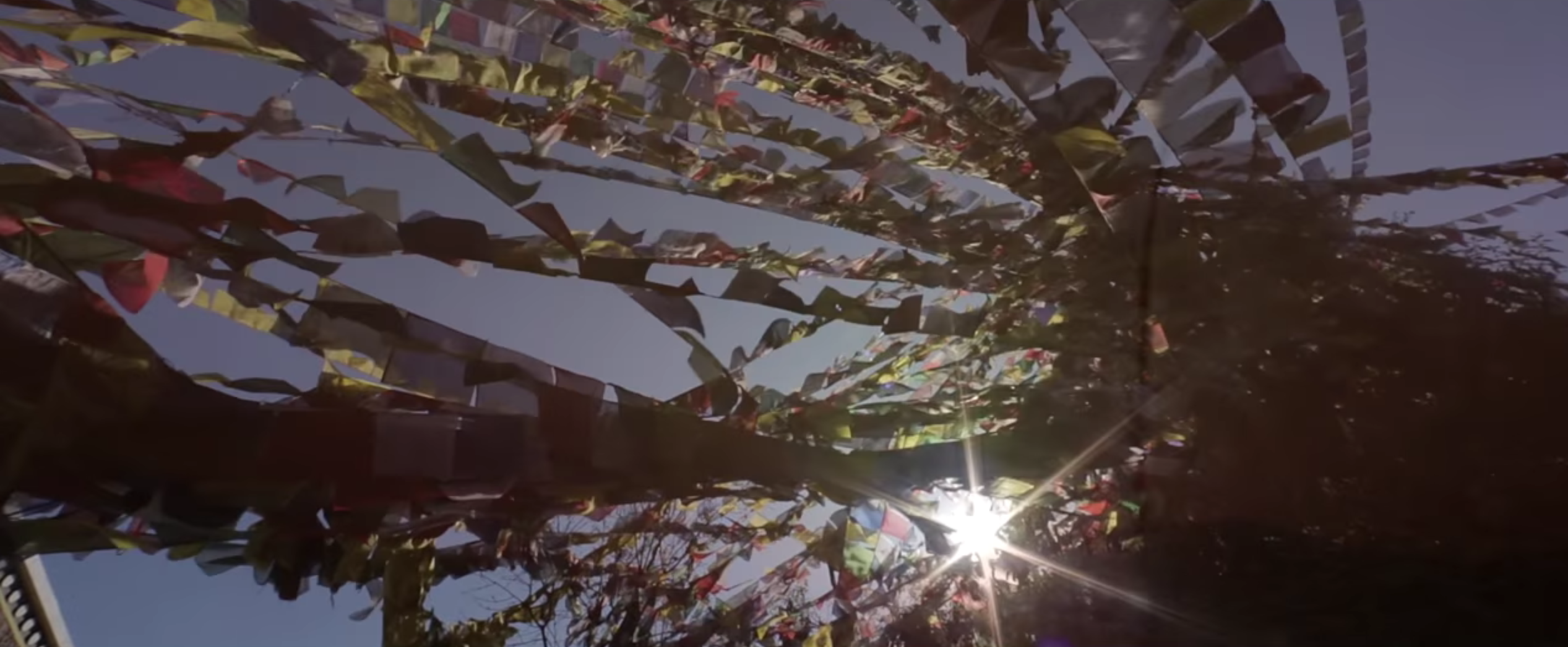 Prayer flags are particularly a Karma family practice, the kind act of spreading prayers to all sentient beings on the winds of Amoghasiddhi and Tara. They are hung up to spread the auspicious wishes on the winds. These Windhorse flags usually have the wind horse symbol (a horse with jewels and flames on his back flying through the air, who is sacred to Amoghasiddhi), with mantras.
Prayer flags are particularly a Karma family practice, the kind act of spreading prayers to all sentient beings on the winds of Amoghasiddhi and Tara. They are hung up to spread the auspicious wishes on the winds. These Windhorse flags usually have the wind horse symbol (a horse with jewels and flames on his back flying through the air, who is sacred to Amoghasiddhi), with mantras.
Often the left hand holds his powerful symbol the double vajra or Vishvavajra. Meditation, symbolized by the meditative mudra of his left hand, is a very profound method for strengthening our Chi or prana in our bodies. One of the many meanings of his double vajra symbol, sometimes seen in this hand, is also a symbol of the unification of the outer and inner body, outer cosmos, and inner chakras. It also represents the five Buddha families, with center and the five spokes.
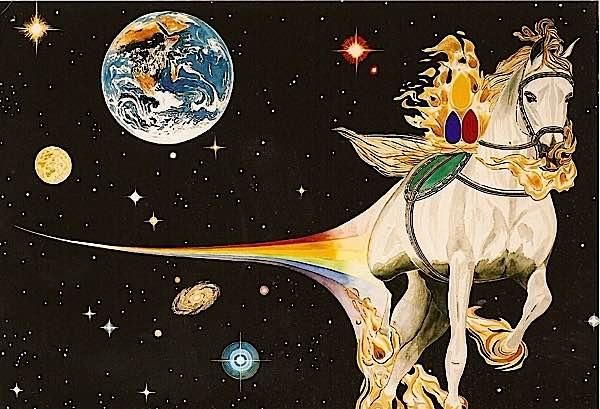 The Tibetan Windhorse is iconic of Lung or wind (Chi, Prana or breath). The Windhorse symbolically carries the prayers and wishes of practitioners to the Universe, carried on the winds of Amoghasiddhi / Tara and the Karma family who govern wind.
The Tibetan Windhorse is iconic of Lung or wind (Chi, Prana or breath). The Windhorse symbolically carries the prayers and wishes of practitioners to the Universe, carried on the winds of Amoghasiddhi / Tara and the Karma family who govern wind.
Amoghasiddhi and Tara’s Karma family element is wind, including the winds in the body, also known as Chi or Prana or Lung. These are the very essence of life. Breath is life, and as long as we are in samsaric realms, wind sustains us. For this reason, many higher yogic practices of Amoghasiddhi or Tara involve inner body meditations on chi, wind and what is called the body mandala, where we visualize Amoghasiddhi or Tara at our various chakras.
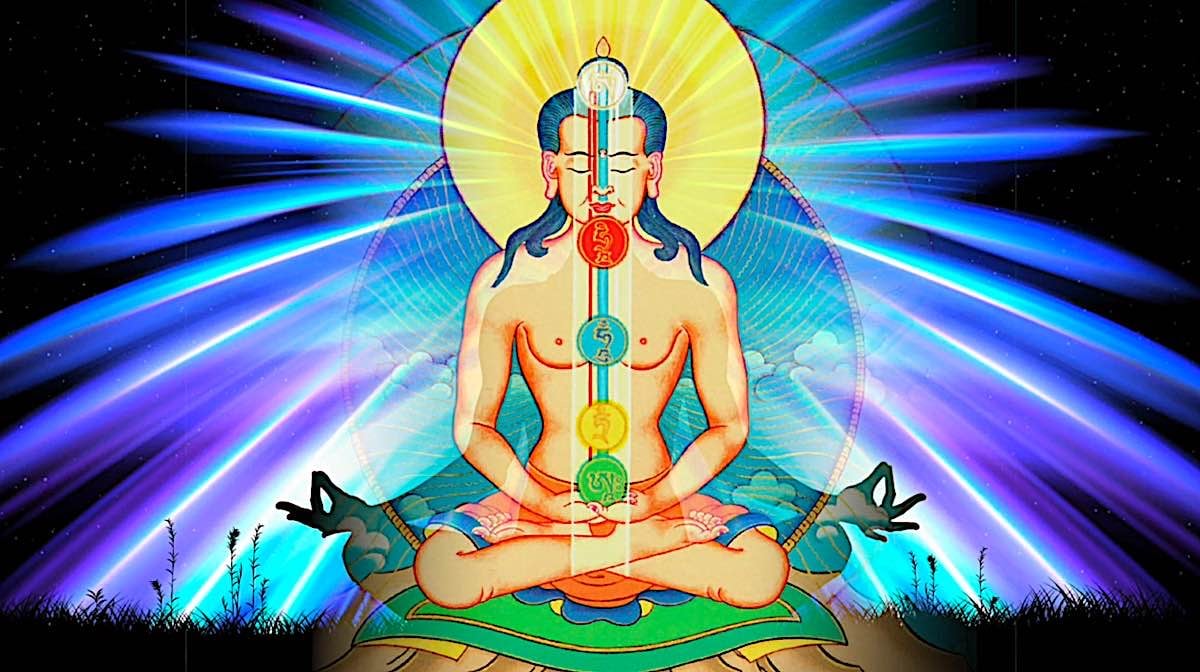 The five main chakras of the five Buddha families. The inner body and the winds that keep us alive — Chi or lung or prajna air — are the domain of Amoghasiddhi Tara, which is the green chakra behind the meditators hands, below the navel, the secret center where winds are generated. Above this chakra are the chakras of the other Buddha Families, which rely on wind for “transportation” of life force through the body (inner universe) — which is where we get the term “WIND HORSE” our mount for transporting the winds of the body. The yellow chakra is Ratnasambhava’s centre, the blue chakra is Akshobhya Buddha’s center, the red is Amitabha’s center at the throat, and the white is Vairochana’s center.
The five main chakras of the five Buddha families. The inner body and the winds that keep us alive — Chi or lung or prajna air — are the domain of Amoghasiddhi Tara, which is the green chakra behind the meditators hands, below the navel, the secret center where winds are generated. Above this chakra are the chakras of the other Buddha Families, which rely on wind for “transportation” of life force through the body (inner universe) — which is where we get the term “WIND HORSE” our mount for transporting the winds of the body. The yellow chakra is Ratnasambhava’s centre, the blue chakra is Akshobhya Buddha’s center, the red is Amitabha’s center at the throat, and the white is Vairochana’s center.
Wisdom, Poison and Symbolism
The Wisdom of Amoghasiddhi’s Karma family is “All-Accomplishing Wisdom” which is the remedy for the poisons of envy and jealousy. The Karma family is literally the compassionate and wisdom activities of all Buddha Families as action. Khenchen Thrangu Rinpoche describes it this way:
“All-accomplishing action is the completion of all that needs to be done. Positive passion is their power and what destroys negativity. It is the opposite of jealousy and paranoia.”
 Jealousy is one of modern life’s main poisons, that drive other poisons such as hate. Amoghasiddhi and the entire Karma family are the wisdom that cures Jealousy as a poison and inner demon.
Jealousy is one of modern life’s main poisons, that drive other poisons such as hate. Amoghasiddhi and the entire Karma family are the wisdom that cures Jealousy as a poison and inner demon.
Jealousy and envy are the cause of nearly every other poison. Envy is the cause of wars on neighbors. Envy makes us angry when we can’t have what we think we want. Envy leads to attachment and clinging to our perceived treasures. Envy and jealousy is the antagonist of love and trust. Greed arises from envying what others have.
Amoghasiddhi’s fearless All-Accomplishing Wisdom overcomes this poison before it degenerates into even more potent poisons like anger and hate. It is only possible through the cultivation of fearlessness. We can overcome envy, or any poison, if we fearlessly admit it’s an issue and pursue positive actions to prevent it.
The fearless mind can accomplish anything, for the benefit of all sentient beings.
 Abhaya, the fearless mudra of Amoghasiddhi.
Abhaya, the fearless mudra of Amoghasiddhi.
Fearlessness and Clarity
Amoghasiddhi’s fearlessness allows us to contemplate with clarity, not afraid of what might be revealed.
His main symbol is the Double Vajra, or Vishva Vajra held in his left hand, a symbol of fearlessness and protection, and also the symbol of the mandala of the Five Buddhas. Amoghasiddhi and Tara’s karma family are best known as the “activity of all the Buddhas” and their activity manifests in the mandala of every Buddha. The VisvaVajra, appearing as two vajras crossed represents the five directions of the mandala, and his activity in all the cosmos.
 The mandala symplified in the form of a double vajra. Each of the direction points represents a Buddha family.
The mandala symplified in the form of a double vajra. Each of the direction points represents a Buddha family.
This symbol represents perfect foundation, perfect practice, perfect activity. For this reason, when teachers visit, or when we sit ourselves for retreat, we often sit on a symbolic Double Vajra symbol or Vishvavajra, just like Amoghasiddhi’s throne. Often this is a cushion with the double vajra symbol, or just a piece of paper with the image underneath our cushion. This represents our aspiration to practice with perfect activity and with fearlessness. [2]
The other symbol of the Karma family is the sword, which cuts through ignorance and obstacles, and represents fearlessness.
 Amoghasiddhi Thangkha. His right hand in the Abhaya and his left hand holding a double vajra upright.
Amoghasiddhi Thangkha. His right hand in the Abhaya and his left hand holding a double vajra upright.
Color Green Symbolizes All Activities
His color is green, the color associated with nature and our samsaric world and the breath of life, or wind. When we think of living things, we think of green for growth and activity.
The Karma family is all about all-accomplishing activities in our world, represented by green nature. Green, in Tibetan Buddhism, also symbolically represents the combining of all colors.
 The Five Dhyani Buddhas, also called Five Wisdom Buddhas, Five Conquerors, Five Jinas. In the center of the galactic mandala is White Vairochana. In front in the east is Blue Akshobhya, to the left in the south is Yellow Ratnasambhava, in the west is Red Amitabha Buddha, in the north is Green Amoghasiddhi. Each are recognizable by their symbolic color and their hand mudras.
The Five Dhyani Buddhas, also called Five Wisdom Buddhas, Five Conquerors, Five Jinas. In the center of the galactic mandala is White Vairochana. In front in the east is Blue Akshobhya, to the left in the south is Yellow Ratnasambhava, in the west is Red Amitabha Buddha, in the north is Green Amoghasiddhi. Each are recognizable by their symbolic color and their hand mudras.
Not all of the members of his family are green, although many are, such as Tara, Vishvapani Bodhisattva, Green Jambhala, Green Vasudhara, and many others. The wrathful heruka of the family is Karma Heruka Vajrakilaya.
 Karma Dakini is the green wisdom dakini of the Karma family. Original painting by Laura Santi, of Laura Santi Sacred Art>>
Karma Dakini is the green wisdom dakini of the Karma family. Original painting by Laura Santi, of Laura Santi Sacred Art>>
Wrathful Windy Activity: Vajrakilaya
Vajrakilaya, who is the most wrathful activity of all the Buddhas, is often called the Karma Heruka, meaning Activity Hero, the wrathful form of Amoghasiddhi’s activity. He is an emanation of the Karma family of Amoghasiddhi. This was explained by Kyabje Garchen Rinpoche in a Q & A teaching on Vajrakilaya:
“In terms of the activities of the five Buddha families, their wrathful enlightened activity is mainly assigned to Amoghasiddhi. So Amoghasiddi is the crown ornament [of Vajrakilaya], while the garuda is more of an outer ornament. There is probably also a deeper meaning to the garuda, but here it is Amoghasiddhi, who represents the wrathful enlightened activity.”
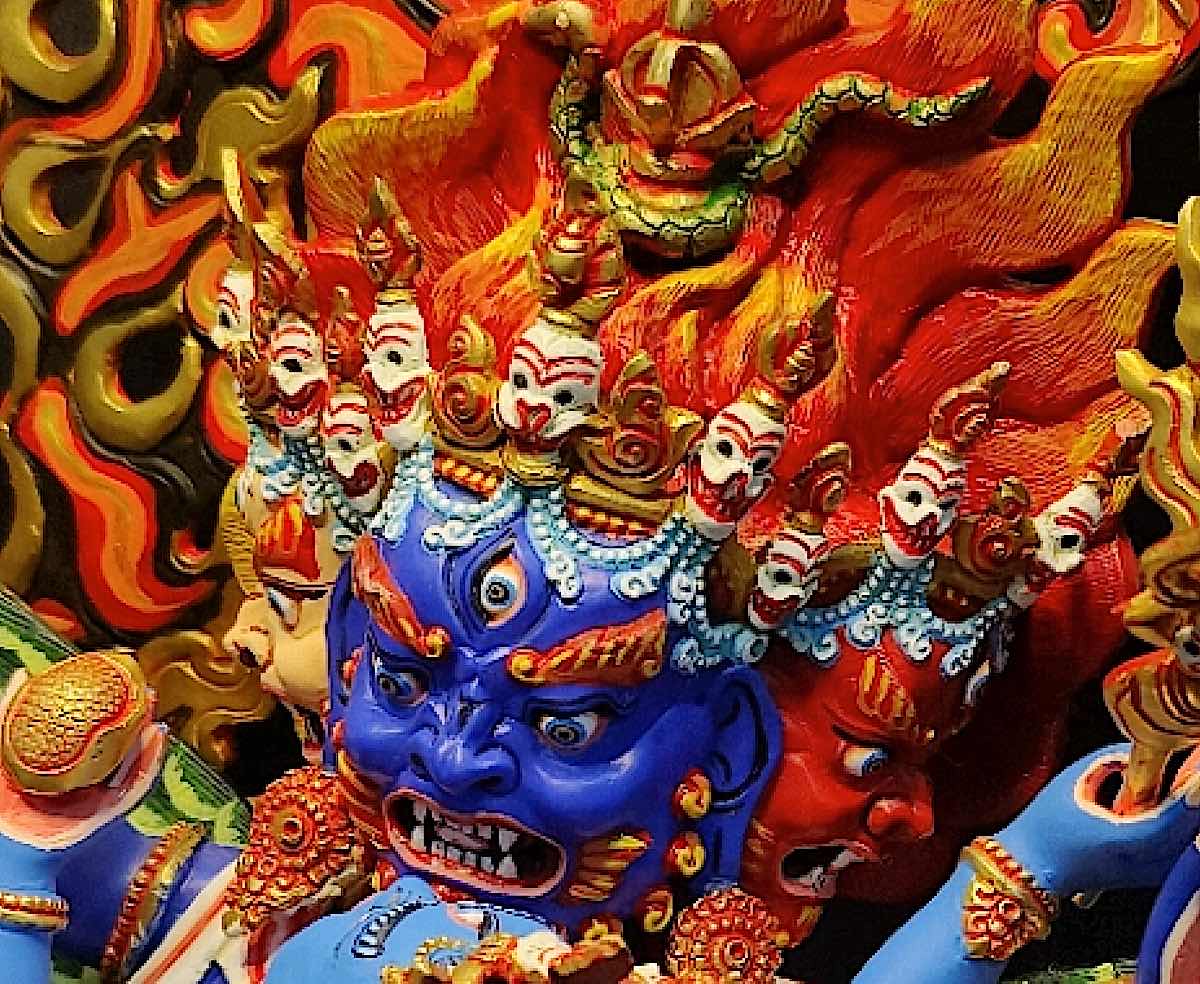 Close up of Vajrakilaya’s fierce faces. The central face and his body are blue, as is his wisdom mother Dakini partner Diptachakra. This was a statue hand painted by Buddha Weekly’s art director.
Close up of Vajrakilaya’s fierce faces. The central face and his body are blue, as is his wisdom mother Dakini partner Diptachakra. This was a statue hand painted by Buddha Weekly’s art director.Garchen Rinpoche also explained that Amoghasiddhi was the chief of the Activity mandala, in his his superb book Vajrakilaya: A Complete Guide with Experiential Instructions:
“Amoghasiddhi, lord of the Karma family… is the chief of this mandala. Among body, speech, mind, attributes, and activities, the accomplishment of enlightened activities is the Karma heruka’s principal purpose.” [4]
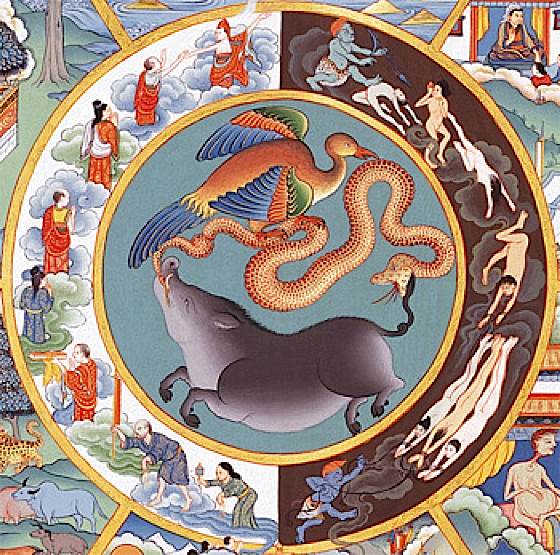 The concept of clinging, suffering and karma are bound up in the cycle of rebirth in Buddhism — driven by karma or our actions, both in the past and in our present. It is the Karma family of Amoghasiddhi who can help purify negative karma and create positive merit for more fortunate circumstances in our lives. The three animals in the center, biting each other’s tails, represent the three main poisons of attachment (peacock), anger (snake) and ignorance (pig). To a great extent envy and jealousy are the “drivers” of those three big poisons.
The concept of clinging, suffering and karma are bound up in the cycle of rebirth in Buddhism — driven by karma or our actions, both in the past and in our present. It is the Karma family of Amoghasiddhi who can help purify negative karma and create positive merit for more fortunate circumstances in our lives. The three animals in the center, biting each other’s tails, represent the three main poisons of attachment (peacock), anger (snake) and ignorance (pig). To a great extent envy and jealousy are the “drivers” of those three big poisons.
Both Amoghasiddhi and Karma are Not Subtle
The profound importance of karma in Buddhism is not subtle. It’s no less than the tempest of practice, and the inspiring practices of Amoghasiddhi Buddha and Green Tara. This is why Amoghasiddhi and Tara are associated with the element of wind.
If we seek peace from the storm of suffering, we can control the outcomes. Like global warming and other negative karmic actions, the damage is reversible, even if it might take considerable effort.
 Amoghasiddhi can be a suitable refuge from the tempestuous storms and winds of samsara. His fearlessness calms the storm.
Amoghasiddhi can be a suitable refuge from the tempestuous storms and winds of samsara. His fearlessness calms the storm.
Shakyamuni Buddha taught the irresistible power of karma, in numerous Sutras, starting with the Four Noble Truths and the Eightfold Path and the Ten Perfections of Practice, and winding through every Sutra teaching. He also gave us the remedies. To inspire the warm, nourishing winds, we rely on the Ten Perfections. To avoid the unimaginable suffering of negative karma is likewise in our control.
The Root of Negative Karma: Envy
It’s fair to say that all the poisons of Buddhism contribute to negative karma, but it is envy that inspires many of the others: anger, attachment, pride, and even delusion. We get angry because we envy what others have. We have pride in our own achievements but still want more. We become deluded, modeling our ideals of success after other people. These are forms of envy.
The remedy for the poison of envy and jealousy are Karma-family practice — or right conduct and action. These are the practices of Amoghasiddhi Buddha, or Mother Tara, or any of the Karma family.
According to Beer’s “The Handbook of Tibetan Buddhist Symbols” (2003), Amoghasiddhi reigns over the Northern direction and the Father Buddha of the Karma family of deities.
“Amoghasiddhi, the All-accomplishing Wisdom Buddha, is linked with the purging of the poison of jealousy and envy, transforming these negative emotions into the wisdom of accomplishment and enlightened activity.” Beer, 2003
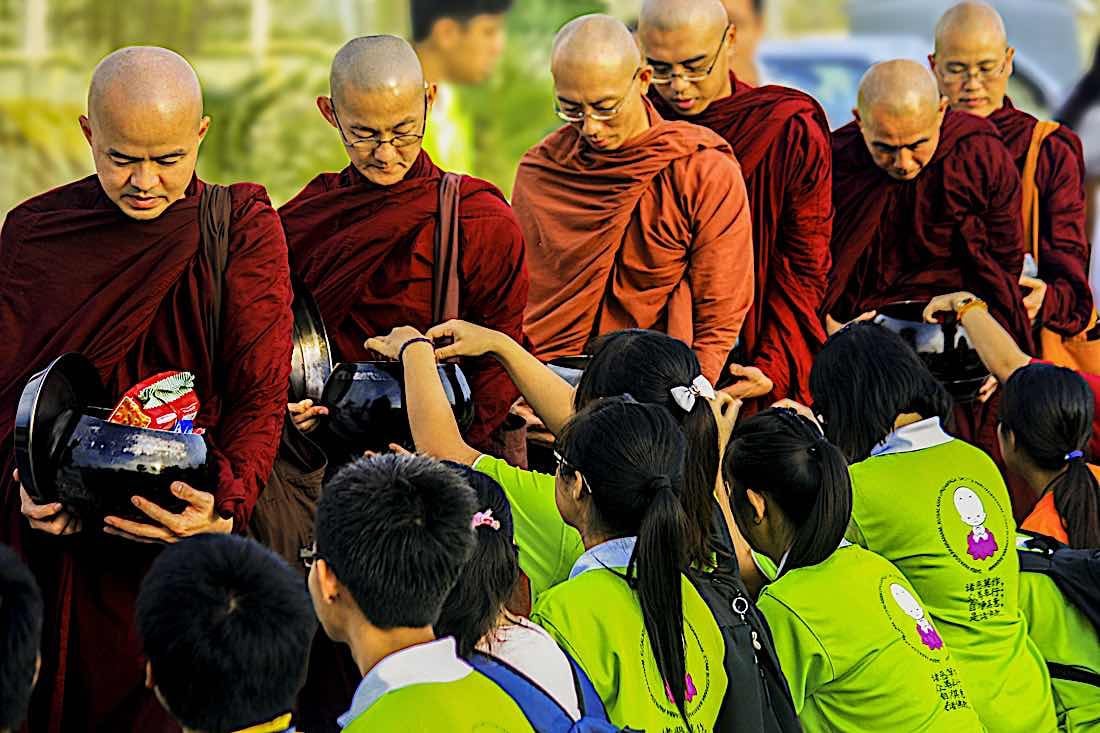 Youth give “dana” to monastic Sangha, a meritorious action. Generosity is a key practice of Amoghasiddhi and Buddhists generally. The positive merit accumulated by the Ten Perfections (which include generosity) purify past negative karma and calm the raging storm of jealousy. Giving to others, helps us feel less “envious” of others.
Youth give “dana” to monastic Sangha, a meritorious action. Generosity is a key practice of Amoghasiddhi and Buddhists generally. The positive merit accumulated by the Ten Perfections (which include generosity) purify past negative karma and calm the raging storm of jealousy. Giving to others, helps us feel less “envious” of others.
When someone asks, “How do I aspire to rebirth in Amoghasiddhi’s Pureland?” the answer is simple. Practice the Ten Perfections to the best of your ability, dedicating the merit for the benefit of all sentient beings. Since Amoghasiddhi’s practice is positive Enlightened Activities, the Ten Perfections become the most important.
The ten Perfections are giving and generosity, moral integrity, renouncing negative behavior, profound understanding and insight, right effort, forbearance, truthfulness, resolve, loving-kindness, and equanimity. They represent the path to complete Enlightenment, often referred to as ‘Buddhahood’, and are central to anyone seeking to follow the karma path of Amoghasiddhi.
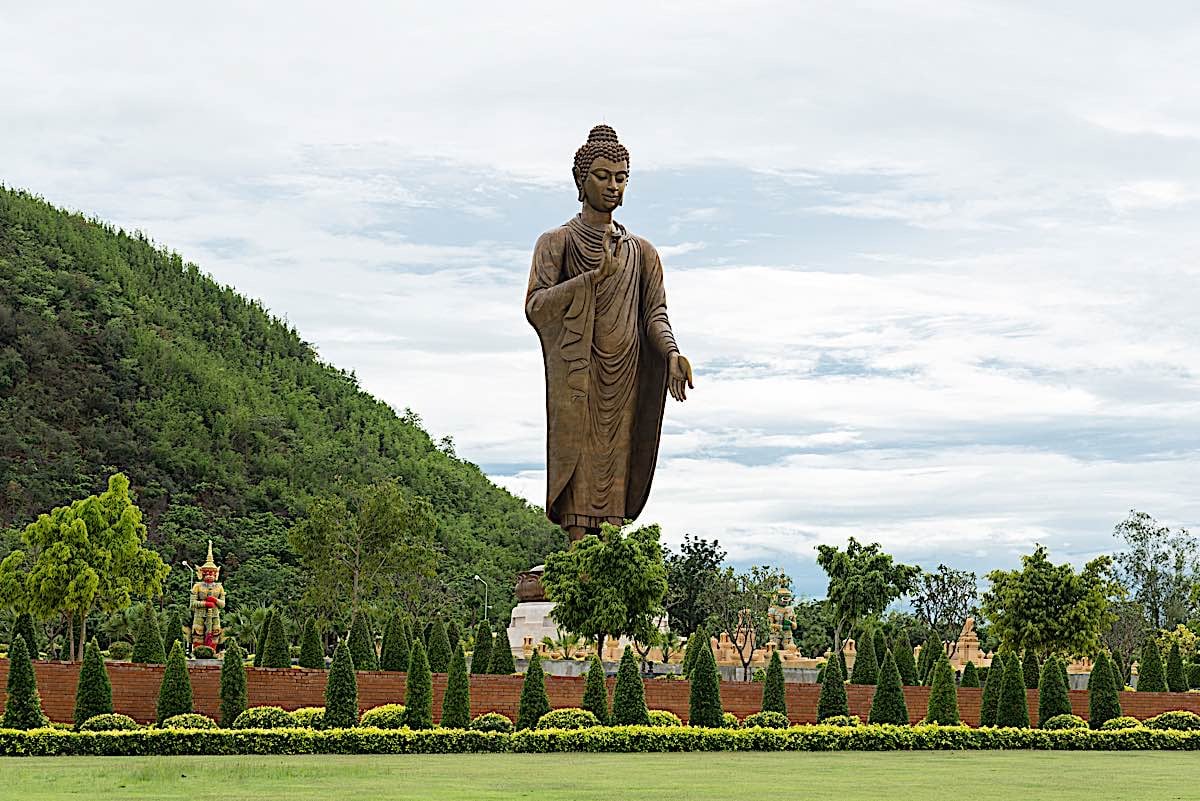 Phra Buddha Metta Pracha Thai Buddha statue at Kanchanaburi. His hands are held in two well-known mudras. In the right hand he banishes our fear with his universal love and compassion, the Abhaya mudra, and his left hand is in the Varuda Mudra of giving and salvation. Giving, generosity, compassion are all acts of unselfish love, as is offering protection. These are the key practices of Amoghasiddhi and the Karma family
Phra Buddha Metta Pracha Thai Buddha statue at Kanchanaburi. His hands are held in two well-known mudras. In the right hand he banishes our fear with his universal love and compassion, the Abhaya mudra, and his left hand is in the Varuda Mudra of giving and salvation. Giving, generosity, compassion are all acts of unselfish love, as is offering protection. These are the key practices of Amoghasiddhi and the Karma family
Thich Nhat Hanh, in his book “The Heart of the Buddha’s Teaching” (1999), elucidates these ten perfections beautifully.
“The ten perfections provide us with the most wholesome ways to respond to any situation. They are the ten kinds of virtuous action that lead us to the ultimate goal of full enlightenment.” Thich Nhat Hanh, 1999
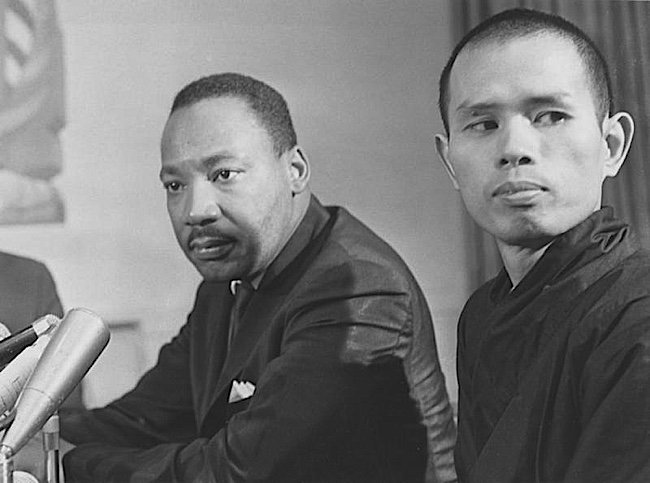 Thich Nhat Hanh (right) with Martin Luther King Jr. who nominated Thay for the Nobel Peace Prize in 1967. The nomination is demonstration of karma in action, as Thay’s tireless efforts and practice of the ten perfections made him Internationally famous.
Thich Nhat Hanh (right) with Martin Luther King Jr. who nominated Thay for the Nobel Peace Prize in 1967. The nomination is demonstration of karma in action, as Thay’s tireless efforts and practice of the ten perfections made him Internationally famous.
Connecting with Amoghasiddhi
Connecting with Amoghasiddhi, as with all Enlightened Buddha is as simple as thinking of him, Taking Refuge, and praising his name or chanting his mantra. This connects you to the fearlessness and unfailing accomplishment karma of Amoghasiddhi. Later in this presentation, we demonstrate a short practice meditation. But, anytime you want to connect to his unfailing activity, simply think of him and chant his name praise.
 Amoghasiddhi Mantra in Sanskrit Siddhim script. VisibleMantra.org
Amoghasiddhi Mantra in Sanskrit Siddhim script. VisibleMantra.org
His Namo praise is
Namo Amoghasiddhi Buddhaya
His mantra is
Om Amoghasiddhi Ah Hum
 Ah Syllable Siddhim text Sanskrit.
Ah Syllable Siddhim text Sanskrit.
His seed syllable or bija is AH, which is, in Sanskrit. Ah is a foundational sound in Buddhism, together with Om and Hum. The three syllables Om Ah Hum are considered a mantra, with all three syllables present in most other mantras, and represent the body, speech and mind of Buddha. Ah is Amoghasiddhi’s sacred syllable.
 Amoghasiddhi mantra in Tibetan calligraphy. Visible Mantra.
Amoghasiddhi mantra in Tibetan calligraphy. Visible Mantra.
A Practice of Amoghasiddhi
Here is a simple practice for Amoghasiddhi which is a frontal visualization, not requiring empowerment. It is always best to receive instruction and transmission when possible, however the wholesome practice or Pujas of any of the Five Dhyani Buddhas does not require permission.
 Beautiful photo of the mountain-top giant statue of Amoghasiddhi on Lantau Island, Hong Kong (Tian Tan Buddha).
Beautiful photo of the mountain-top giant statue of Amoghasiddhi on Lantau Island, Hong Kong (Tian Tan Buddha).
Take Refuge
Start by Taking Refuge in the Three Jewels. This is followed by the Bodhichichitta intention, stated outloud, to benefit all sentient beings. Visualize Amoghasiddhi, or Amoghasiddhi with Green Tara, in front of you with as vivid a mental picture as you can. It can help to have a picture or statue on a higher table or altar — higher than your seat — with offerings in front of the image. These can be offerings of water, incense, flowers, fruit, or any vegetarian offerings.
Offerings
As the karma Buddha, it is best to offer vegetarian to ensure your offerings have the best karmic potential.
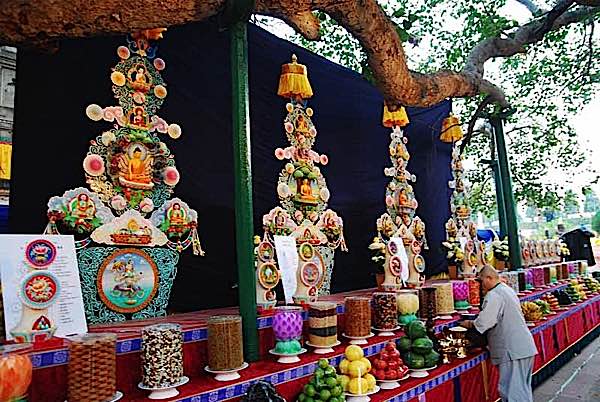 Offerings can be simple or elaborate, or even imagined, but should be vegetarian for the karma family to ensure no negative karma is attached to the offering. Notice the piles of fruit, suites and elaborate cake tormas. These are, of course, supreme offerings at Bodh Gaya, so are not typical offerings we might make at home. Even a row of water bowls is a wholesome offering to the Karma family.
Offerings can be simple or elaborate, or even imagined, but should be vegetarian for the karma family to ensure no negative karma is attached to the offering. Notice the piles of fruit, suites and elaborate cake tormas. These are, of course, supreme offerings at Bodh Gaya, so are not typical offerings we might make at home. Even a row of water bowls is a wholesome offering to the Karma family.
Purification and 7 Limbs of Practice
It is best to confess your downfalls in karmic activity, now and in the past, and promise to refrain. Think of your activities through the day, especially negative ones that might imprint negative karma, and vow to yourself to refrain from such negativity in future.
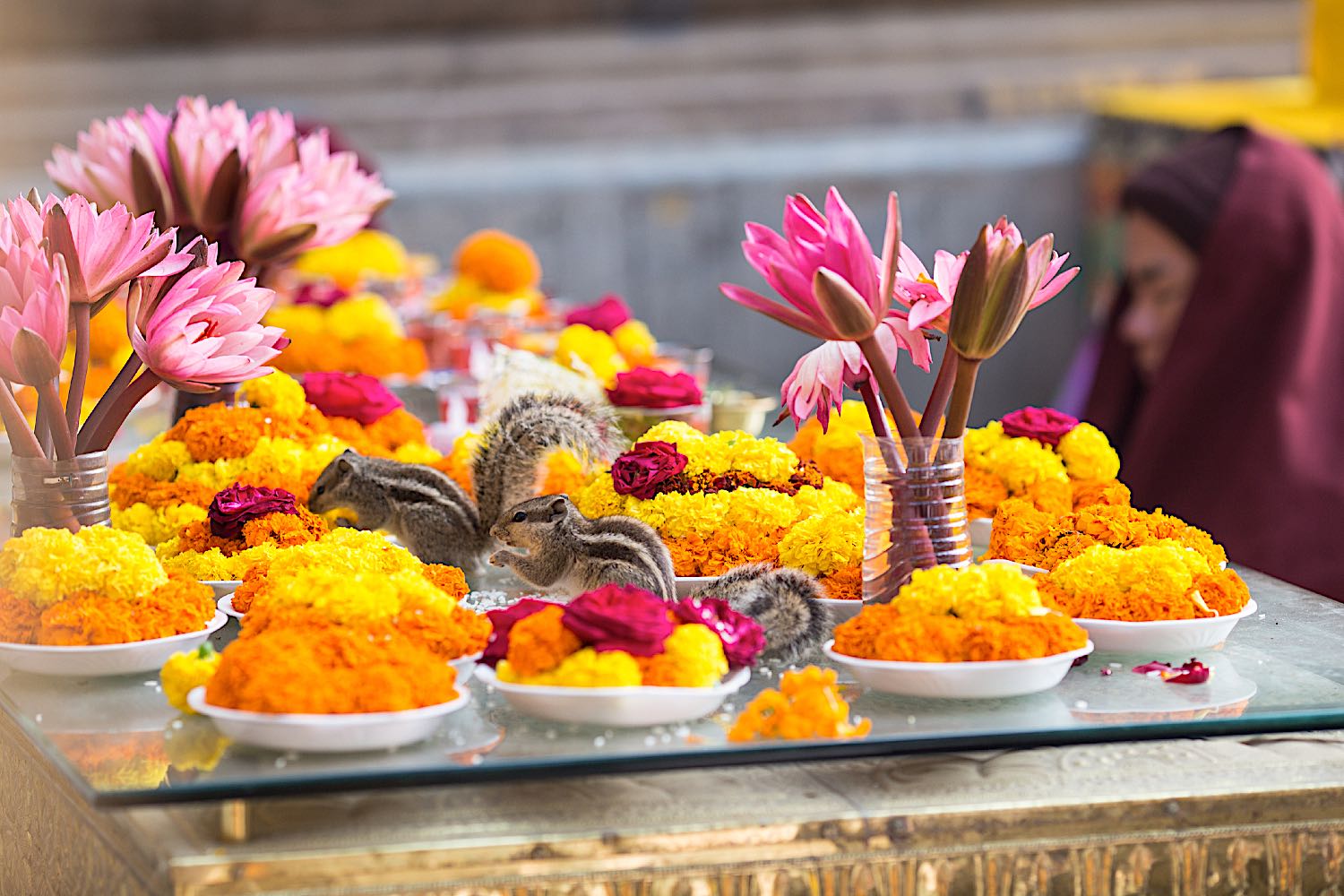 Flowers are another delightful offering, delighting the “sense” of seeing.
Flowers are another delightful offering, delighting the “sense” of seeing.
If you have time, it can be helpful to chant and meditate on Vajrasattva mantra, or chant the King of Prayers with a devoted heart. Look for other presentations on Buddha Weekly for both of these practices. Otherwise, ideally, with a devoted heart, state the seven limbs if you have time. These are:
Prostration and devotion, which purifies the poison of our arrogance. Offerings to all the Buddhas and Bodhisattvas without exception which purifies the poison of greed. Confession of Negativity and past faults, which purifies the poison of anger. Rejoicing the virtue of all Buddhas and Bodhisattvas, which purifies the poison of wrong views. Requesting the Buddhas and Bodhisattvas continue to turn the wheel of Dharma and teachings, which purifies the poison of doubt. Requesting the Bodhisattvas not pass into Nirvana, asking they remain in Samsara to save all beings from suffering, which purifies the poison of ignorance. Dedicating the merit of all devotion, offerings and practice to the benefit of all sentient beings, which purifies the poison of jealousy.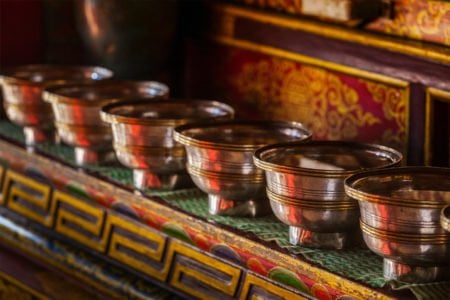 Water bowls are a wholesome offering representing purity. The karma family activity is very active in purifying negative karma, making this a very suitable, pure offering.
Water bowls are a wholesome offering representing purity. The karma family activity is very active in purifying negative karma, making this a very suitable, pure offering.
Visualize Amoghasiddhi and Field of Merit
With a stable image in your mind of Amoghasiddhi, chant his namo praise and mantras.
Ideally, as you chant, visualize green light emitting from his seed syllable AH at his heart and entering your heart, filling you with his karma-purifying light and his chi or life-force. A better visualization is to imagine the green light going out to the entire universe, reaching the farthest reaches of space, and then returning instantly to be absorbed into your heart.
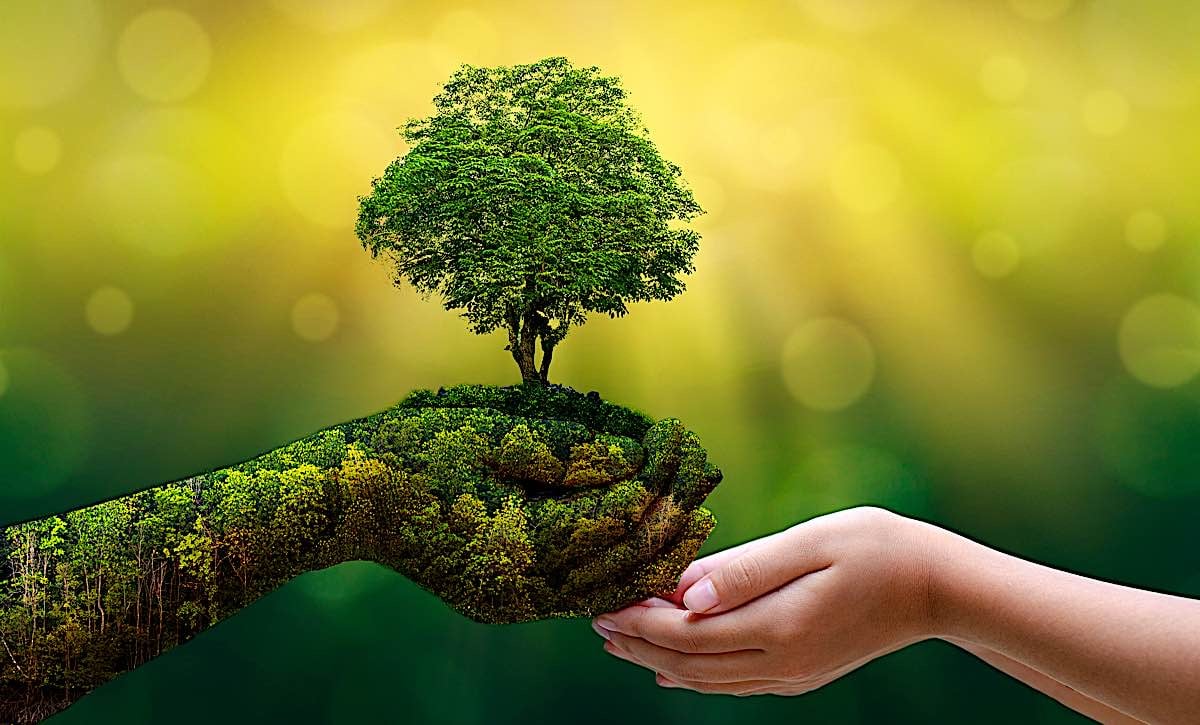 We visualize green and green light to symbolize nature and growth and pristine purity. This is the sacred color of Amoghasiddhi, Tara and the Vajra family.
We visualize green and green light to symbolize nature and growth and pristine purity. This is the sacred color of Amoghasiddhi, Tara and the Vajra family.
When you have finished your empowering meditation, you dedicate the merit to the cause of Enlightenment to benefit all sentient beings.
Amoghasiddhi Short Practice
Here is a short Amoghasiddhi Practice. If you do not have Amoghasiddhi or Green Tara empowerments (either qualifies you to practice self generation), you would visualize the merit field of Amoghasiddhi and Tara in front of you as described below.
 Prostration is important and one of the seven limbs of Amoghasiddhi practice. If we are physically not able to fully prostrate, at least we bow our heads to folded hands. Even if you have no picture or altar you visualize Amoghasiddhi in front of you.
Prostration is important and one of the seven limbs of Amoghasiddhi practice. If we are physically not able to fully prostrate, at least we bow our heads to folded hands. Even if you have no picture or altar you visualize Amoghasiddhi in front of you.
This is in English for this presentation, except for Refuge and Bodhichitta which are in Sanskrit and English and the mantras.
For the 7 Limb Practice, which includes offerings, confession, and dedication in Sanskrit, the best practice is Samantabadhra’s King of Prayers, although here we have a very short Seven Limb practice with the Four Immeasurables. See our linked video to the King of Prayers chanted in Sanskrit.
 Ah Syllable Siddhim text Sanskrit.
Ah Syllable Siddhim text Sanskrit.
The Puja says to start by visualizing the AH syllable in front of you in the North. Even if you are facing west or south, you mentally visualize that you are facing north. The syllable and light is normally green, the color of activity, and blending of all colors.
Taking Refuge
namo amoghasiddhi buddhaya
namo buddhaya guruve
namo dharmaya tayine
namo samghaya mahate
tribhyopi satatam namah
Homage to Amoghasiddhi Buddha
Homage to the Buddha, the Teacher
Homage to the Dharma, the Protector
Homage to the Great Sangha
To all of these I continually offer homage.
Seven Limbs Including the Four Immeasurables
I go for refuge on this enlightening path
To Amoghasiddhi, the Buddhas, the Dharma and the Highest Assembly.
I declare every nonvirtuous act since beginningless time.
I rejoice in all virtues of holy and ordinary beings.
I will cultivate the Bodhichitta, to most effectively benefit all sentient beings.
Having generated the intention to take the Buddha’s path
I will care for all sentient beings as my guests.
I offer flowers, incense, light, fragrances, food, music and the like, both those actually arranged and those mentally imagined. Supreme gathering, please accept them.
For the great, supreme Karma family, I shall uphold purely each of vows I am endowed with, and make as many offering as I am able.
I will practice the ten perfections and overcome all obstacles.
And cultivate the Bodhichitta.
I wish that all beings may have happiness and its causes.
May we never have suffering nor its causes
May we constantly dwell in joy transcending sorrow
May we dwell in equal love for both near and far.
Please remain in Samsara and turn the Wheel of the Dharma of the greater and lesser vehicles, to benefit all sentient beings!
 A merit field can be a difficult visualization and is not necessary in daily practice. This is one merit field, a mandala of 17 deities with Amoghasiddhi and Tara in the center of the Mandala, and a large entourage. Normally, we just try to focus on the main deity for now.
A merit field can be a difficult visualization and is not necessary in daily practice. This is one merit field, a mandala of 17 deities with Amoghasiddhi and Tara in the center of the Mandala, and a large entourage. Normally, we just try to focus on the main deity for now.
Visualize the Merit Field
Appearances and existence, all phenomena of samsara and nirvana are empty by nature. Realizing this, within that state of emptiness, I visualize a glowing, illuminated Green AH syllable sitting on a shining lotus throne.
Green Light, the activity of all the Buddhas, emanates from the AH syllable, going out as an offering to all the Enlightened Beings, and purifying the karma of all sentient beings in the universe, blessing them. The lights return and the AH syllable transforms into glorious Amoghasiddhi, Green in Color, seated upon a lotus and moon.
I see luminous Amoghasiddhi Buddha, the nature of light, peaceful and loving, the very essence of Bodhichitta activity. He is seated in the lotus posture, with his right hand up in the gesture of Fearlessless, the Mudra of Abhaya. His left hand is on his lap in the gesture of meditative equipoise, and holding an upright Vishva Vajra, a double dorje.
At his heart is a green AH syllable. From this syllable, once again lights go out to al of the universe, first out to his green Pureland, then to every Pureland of every Buddha and finally to all beings in Samsaric worlds in every dimension and universe. The sacred light of Amoghasiddhi’s blessings is an offering to all the Enlightened ones, and blesses all beings of Samsara.
Mantra
Om Amoghasiddhi Ah Hum
Om Amoghasiddhi Ah Hum
Om Amoghasiddhi Ah Hum.
Finishing and Dedication
Hold the visualization as long as you can while chanting the mantra. Finish by visualizing Amoghasiddha and the merit field dissolving into green light, and then absorbing in into your heart chakra, blessing you and staying with you at all times, protecting you from all harm. Know that you are protected by Amoghasiddhi and Tara at all times.
Then, finish with a dedication of merit. Because this is the karma family, who are responsible for all Bodhisattva Activity benefiting all beings, the dedication of merit is the most important practice.
It can be as simple as:
I dedicate the merit of this practice and offerings to the cause for Enlightenment for the benefit of all sentient beings.
We dedicate the merit of this presentation to the benefit of all sentient beings.
NOTES
[1] Amoghasiddhi, the Five Buddhas, The Zen Gateway https://www.thezengateway.com/teachings/the-five-wisdom-buddhas-amogasiddhi
[2] Amoghasiddhi http://cubuddhism.pbworks.com/w/page/24878050/Amoghasiddhi
[3] Garchen Rinpoche, Kyabje. Vajrakilaya: A Complete Guide with Experiential Instructions (p. 177). Shambhala. Kindle Edition.
[4] Garchen Rinpoche, Kyabje. Vajrakilaya: A Complete Guide with Experiential Instructions (pp. 153-154). Shambhala. Kindle Edition.
[5] Vessantara. A Guide to the Buddhas (Meeting the Buddhas Book 1) (pp. 111-112). Windhorse Publications. Kindle Edition.
[6] Vessantara. A Guide to the Buddhas (Meeting the Buddhas Book 1) (p. 114). Windhorse Publications. Kindle Edition.

 Tfoso
Tfoso 








